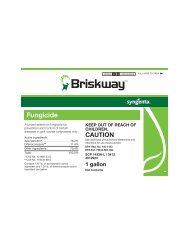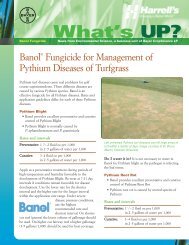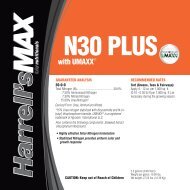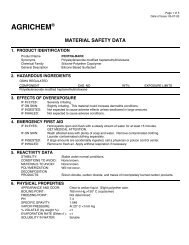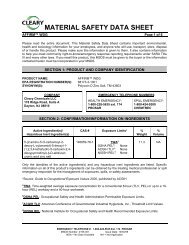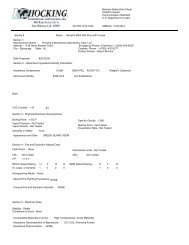Nufarm Chlorpyrifos SPC 4 label.pdf - Tom Irwin
Nufarm Chlorpyrifos SPC 4 label.pdf - Tom Irwin
Nufarm Chlorpyrifos SPC 4 label.pdf - Tom Irwin
You also want an ePaper? Increase the reach of your titles
YUMPU automatically turns print PDFs into web optimized ePapers that Google loves.
<strong>Chlorpyrifos</strong>_<strong>SPC</strong>_4_INSCT.2.5G_Book_layout 1 11/9/10 3:21 PM Page 12<br />
ORNAMENTALS IN GREENHOUSES (PREPLANT INCORPORATION TREATMENT OF<br />
FIELD GROWN NURSERY STOCK)<br />
White Grubs and White Fringed Beetles:<br />
To control white grubs and white fringed beetles during transplant or seedling establishment, apply this product to soil and incorporate before<br />
transplanting or planting. Apply to the soil surface as a broadcast spray at a rate of 1 quart per acre using sufficient water to obtain adequate coverage.<br />
Do not make aerial applications. On the same day of treatment, incorporate the insecticide into the top 2 to 4 inches of the soil using a tandem disc,<br />
field cultivator or equivalent incorporation equipment capable of thorough soil mixing.<br />
Precaution: Environmental factors and varietal variation can significantly affect the potential for phytotoxicity from pesticide use. This product has been<br />
evaluated at the above indicated rate on loblolly pine without phytotoxic effects. Prior to making large-scale applications, growers should prepare and<br />
observe a small test plot as above in order to determine the potential phytotoxicity in species or varieties other than loblolly pine. Use the following<br />
procedure: (1) Treat a small test block as above; (2) Seed or transplant the test species or variety and observe for symptoms of phytotoxicity for a<br />
minimum of 14 days following emergence or transplanting.<br />
Note: The professional user assumes responsibility for determining if this product is safe to treated plants under commercial growing conditions.<br />
Garden Symphylans:<br />
Apply this product as a preplant incorporated treatment to suppress garden symphylans on land to be planted to field grown ornamentals. Apply as a<br />
broadcast application to the soil surface at the maximum rate of 1 quart per acre in at least 10 gallons of water per acre. On the same day of treatment,<br />
incorporate the insecticide to a depth of up to 8 inches using a disc, rotovator or other suitable equipment. Use the higher rate range for longer residual<br />
control or where deeper incorporation is necessary.<br />
Precaution: Environmental factors significantly affect phytotoxicity. This product has been tested on numerous ornamental plants without causing<br />
serious phytotoxicity. However, because of the numerous varieties grown, treat a small group of plants at the specified rate under the anticipated<br />
growing conditions and observe for phytotoxic symptoms for at least 7 days, before a large number of plants are treated. Do not blend this product<br />
with dry bulk fertilizer materials.<br />
NOTE: The professional user assumes responsibility for determining if this product is safe to treated plants under commercial growing conditions.<br />
TREE PESTS IN GREENHOUSES<br />
Use this product to treat shade and flowering trees, and evergreens infested with pests listed in the following table. Dilute this product with water<br />
according to the directions given in the table and apply using suitable hand- or power-operated spray equipment in a manner to provide complete and<br />
uniform coverage. Apply a coarse spray to thoroughly wet both the upper and lower leaf surfaces and to infested limb and trunk areas. Attempt to<br />
penetrate dense foliage, but avoid overspraying to the point of excessive runoff. Treat when pests appear and repeat application at 7 to 10 day intervals,<br />
if needed. Consult your State Agricultural Experiment Station or Extension Service specialist for application timing and other specific use information<br />
applicable to your area.<br />
12



